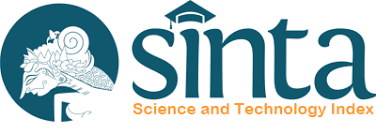Peningkatan Layanan Informasi BRT Trans Jateng berbasis Chatbot Telegram menggunakan Framework Rasa
Keywords:
Chatbot, Telegram, Rasa Open Source, Informasi, BRTAbstract
Minimnya ketersediaan informasi terkait moda transportasi BRT Transjateng, terutama BRT Transjateng rute Terminal mangkang – Terminal bahurekso. Penelitian ini bertujuan untuk mengembangkan sebuah sistem yang mampu memberikan tanggapan secara otomatis, cepat, akurat terhadap pertanyaan pengguna dengan menyediakan informasi yang relevan, khususnya informasi mengenai Brt Trans Jateng rute Terminal Mangkang hingga Terminal Bahurekso dan berkontribusi dalam upaya Peningkatan pelayanan informasi kepada pengguna. Salah satunya adalah dengan menggunakan chatbot dengan Framework Rasa, Framework Rasa merupakan sebuah kerangka kerja (framework) dalam bidang machine learning yang bersifat open source, yang digunakan untuk mengotomatisasi pemrosesan teks dan percakapan berbasis suara, dengan metode pengujian menggunakan metode Blackbox Testing dan User Aceptance Test (UAT). Hasil pengujian menggunakan metode Blackbox Testing menghasilkan tingkat validasi yang tinggi dan pengujian menggunakan metode User Aceptance Test (UAT) menghasilkan 89% dari 30 responden yang terdiri dari mahasiswa dan Masyarakat yang hampir setiap harinya menggunakan moda Transportasi BRT Transjateng rute Terminal Mangkang – Terminal Bahurekso menyatakan bahwa aplikasi chatbot telegram ini dapat membantu pelayanan yang terkait dengan informasi pada moda transportasi BRT Transjateng rute terminal mangkang-terminal bahurekso menjadi lebih cepat, fleksibel dan efisienReferences
ITDP, The BRT Standart 2016. 2016.
J. Hill, W. Randolph Ford, and I. G. Farreras, “Real conversations with artificial intelligence: A comparison between human-human online conversations and human-chatbot conversations,” Comput Human Behav, vol. 49, pp. 245–250, 2015, doi: 10.1016/j.chb.2015.02.026.
S. and N. P. Russell, Artificial Intelligence A Modern Approach, Fourth Edition. Pearson. Pearson Series in Artificial Intelligence, 2020.
S. Vajjala, B. Majumder, A. Gupta, and H. Surana, “Practical Natural Language Processing A Comprehensive Guide to Building Real-World NLP Systems.”
“Natural Language Processing in Action, Second Edition MEAP V09.”
N. N. Khin and K. M. Soe, “University Chatbot using Artificial Intelligence Markup Language.”
E. H. Almansor and F. K. Hussain, “Survey on Intelligent Chatbots: State-of-the-Art and Future Research Directions,” in Advances in Intelligent Systems and Computing, Springer Verlag, 2020, pp. 534–543. doi: 10.1007/978-3-030-22354-0_47.
K. D. Tillotson, “Implementation, Analysis, and Evaluation of A Humanized Information Retrieval ChatBot,” South. Univ. A&M Coll. Johor, 2012.
V. Boddula, A. Rao Polkampally, S. Sohail, and S. Sumair Pasha, “CHATBOT USING RASA,” 1171. [Online]. Available: www.irjmets.com
X. Zheng, S. M. Ismail, and T. Heydarnejad, “Social media and psychology of language learning: The role of telegram-based instruction on academic buoyancy, academic emotion regulation, foreign language anxiety, and English achievement,” Heliyon, vol. 9, no. 5, May 2023, doi: 10.1016/j.heliyon.2023.e15830.
Telegram, “End-to-End encryption, secret chats.”
Mohit Saini, “Using the DIET classifier for intent classification in dialogue,” medium.com.
Rakesh Kumar Sharma, “An Analytical Study and Review of open source Chatbot framework, Rasa,” International Journal of Engineering Research and, vol. V9, no. 06, Jun. 2020, doi: 10.17577/IJERTV9IS060723.
T. T. Nguyen, A. D. Le, H. T. Hoang, and T. Nguyen, “NEU-chatbot: Chatbot for admission of National Economics University,” Computers and Education: Artificial Intelligence, vol. 2, Jan. 2021, doi: 10.1016/j.caeai.2021.100036.
A. Muhyidin, M. A. F. Setiawan, and Nurkhamid, “Developing UNYSA Chatbot as Information Services about Yogyakarta State University,” in Journal of Physics: Conference Series, IOP Publishing Ltd, Jan. 2021. doi: 10.1088/1742-6596/1737/1/012038.
Y. Windiatmoko, R. Rahmadi, and A. F. Hidayatullah, “Developing Facebook Chatbot Based on Deep Learning Using RASA Framework for University Enquiries,” IOP Conf Ser Mater Sci Eng, vol. 1077, no. 1, p. 012060, Feb. 2021, doi: 10.1088/1757-899x/1077/1/012060.
R. Vannala, S. B. Swathi, and Y. Puranam, “AI Chatbot For Answering FAQ’s,” in 2022 IEEE 2nd International Conference on Sustainable Energy and Future Electric Transportation (SeFeT), IEEE, Aug. 2022, pp. 1–5. doi: 10.1109/SeFeT55524.2022.9908774.
F. Sethi, “FAQ (Frequently Asked Questions) ChatBot for Conversation,” International Journal of Computer Sciences and Engineering Open Access Research Paper, vol. 8, no. 10, 2020, doi: 10.26438/ijcse/v8i10.710.
ngrok, “secure introspectable tunnels to localhost,” https://ngrok.com/product.
R. Setiawan, “Black Box Testing Untuk Menguji Perangkat Lunak,” www.dicoding.com.
I. Afrianto, A. Heryandi, A. Finadhita, and S. Atin, “Work From Home Program,” International Journal of Information System & Technology Akreditasi, vol. 5, no. 3, pp. 270–280, 2021, [Online]. Available: https://tt-el.my.id/.
E. C. Dos Santos, P. Vilain, and D. H. Longo, “A systematic literature review to support the selection of user acceptance testing techniques,” in Proceedings of the 40th International Conference on Software Engineering: Companion Proceeedings, New York, NY, USA: ACM, May 2018, pp. 418–419. doi: 10.1145/3183440.3195036.
S. Ul Haq and U. Qamar, “Ontology Based Test Case Generation for Black Box Testing,” in Proceedings of the 2019 8th International Conference on Educational and Information Technology, New York, NY, USA: ACM, Mar. 2019, pp. 236–241. doi: 10.1145/3318396.3318442.









